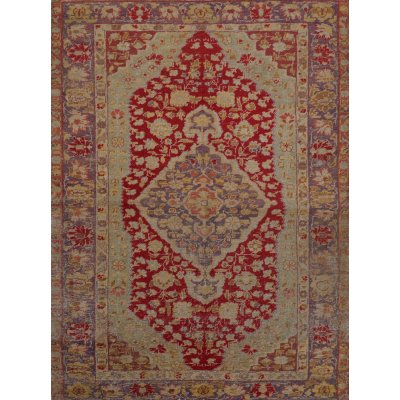Rug Guides: Oriental Rugs
The term Oriental rug is used to describe rugs produced in Asia, or “the Orient.” Unbeknownst to many, the term “Oriental rug” is not factually correct, but it has nonetheless cemented itself as frequently used terminology over centuries.

Today, “Oriental” is used as a convenient catch-all for rugs produced in the historic “Rug Belt.” This area includes a wide array of cultures and religions, including but not limited to China, Turkey, Tibet, India and Iran. Therefor, what qualifies as an Oriental rug stretches far and wide.
Many people don’t realize that when they seek out Oriental rugs, they are looking far beyond what they know to be “Asia.” In fact, when searching for an Oriental rug, people are actually looking for Persian, Chinese, Indian, Tibetan, Kurdish, Caucasian, Anatolian, Central Asian or Turkestanian designs. Not included in the Oriental Rug grouping are rugs and carpets made in Europe.
Oriental rugs are made by hand, either pile woven or flat woven. Cotton, silk and wool are the primary materials used in Oriental rugs. Antique Oriental rugs are dyed with vegetal dyes made from plants and animals. Many Oriental rugs show a variable change in color called abrash. The slight inconsistency is due to batches of wool being dyed separately, one at a time.
It’s important to note that “Oriental” is sometimes used to describe a particular aesthetic. When applied in this way, it’s likely meant to describe Oriental rugs with curvilinear designs — those that are floral in nature. The other major type of rug design is rectilinear, which encompasses geometric patterns. There are hundreds of examples of rectilinear Oriental rugs, as well. Within all patterns of an Oriental rug are meaningful symbols that represent the geographical and cultural region in which they were made. They are highly individualized and representative of their weaver, commissioner (like a royal court), or territory.
The most widely known recognized types of “Oriental rug” is usually Khotan. Antique Khotan rugs and carpets were produced in the oasis town of Eastern Turkestan, today part of the Xinjiang region in Western China. This area has had a steady production of carpets since the 17th century, peaking in the 18th and 19th centuries. Khotan rugs and carpets tend to be geometric with abstract drawings with color palettes of rich colors to soft pastels.
Included Styles
Agra
Carpet-making in India goes back as far as the Mughal emperors of the 16th and 17th centuries. Carpets were woven by Persian craftsmen who traveled to India at the invitation of the Mughal Emperor Akbar (1556-1605). Agra is a city in India, south of Dehli, and has been a key carpet manufacturing center.
During the 19th century, British merchants for the East India Company set up many more carpet factories in several Indian cities, including Agra. The merchants specified designs that were in line with and adapted to Western taste, creating a synthesis of Persian and Indian motives. Motives, such as central medallions are clear evidence of Persian influence, while many other Agra designs presents all-over and centralized patterns.
Caucasion / Kazak
Antique Caucasion rugs were woven by tribal weavers of the south Russian region, near the Caucasus mountains, between the Black and Caspian seas. Although, Caucasion carpets were made by many different tribal groups, they have many common characteristics. Sought after by collectors and designers, these carpets are characterized by their colorful and bright palette. Colors of blue, red, yellow, green, navy, black, and beige can all be combined in one rug. The patterns are very geometric, assertive, and bold, and the common designs tend to be stripes, crosses, squares, diamonds, hexagons, triangles, or even some geometric animal or human figures. Some of the most famous Caucasion styles includes sub-categories such as Kazak, Karabagh, Gendje, Talish, Shirvan, Baku, Kuba, and Daghestan.

Caucasion Rug
- 25220HC
- 3' 8'' x 14' 4''

Caucasion Rug
- 25151HM
- 3' 10'' x 8' 10''

Caucasion Rug
- 25144HM
- 9' 0'' x 12' 5''
Karabagh
The old province of Karabagh lies to the north of the Aras river, just north of the present Iranian border. Karabagh rugs are known for their exceptional quality and highly desired designs sought after by collectors and designers. Their designs and color schemes are closely related to Caucasian rugs with tribal geometric and large medallion patterns. Certain Karabagh rugs also resemble Persian designs and colors with flower ornaments and more traditional designs. Commonly stout and comparatively coarse, Karabagh rugs are all made of wool, are double wefted and have a higher pile than rugs found elsewhere in Caucasus.

Antique Karabagh Rug
- 24897HC
- 3' 8'' x 21' 1''

Antique Karabagh Rug
- 23779HM
- 3' 5'' x 14' 0''

Antique Karabagh Rug
- 20405HM
- 3' 5'' x 14' 11''
Sivas
Sivas is a city in North Central Turkey, which is a major production site of Turkish rugs based on Persian designs. Often finely woven, Sivas rugs and carpets are highly appreciated as some of the best-made and decorative rugs from Turkey. They are classically derived from Persian designs, exploiting all-over patterns and medallions using palmettes and vine scrolls. Sivas rugs tend to have soft color tones with an emphasis on ivory earth tones and pastel coloration in the accent colors. They are excellent decorative rugs for elegant room settings.

Antique Turkish Sivas Rug
- 24842HM
- 4' 1'' x 5' 5''

Antique Turkish Sivas Rug
- 16765HM
- 9' 11'' x 14' 4''

Antique Turkish Sivas Rug
- 14003HM
- 4' 6'' x 6' 7''
You cart is empty. Shop now





